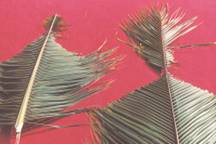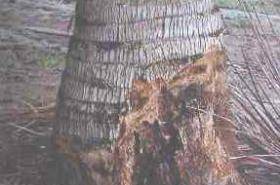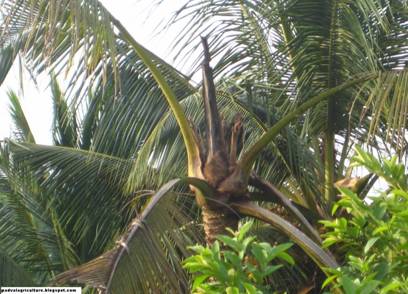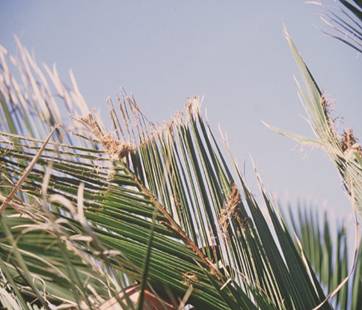Crop Protection :: Coconut
Important pests of Coconut
Scientific name: Cocus nucifera Family: Arecaceae Local name: Mnazi (Swahili)
|
1. Rhinoceros beetle: Oryctes rhinoceros |
Symptoms of damage
- Central spindle appears cut or toppled
- Fully opened fronds showing characteristic diamond shaped cuttings
- Holes with chewed fibre sticking out at the base of central spindle.
|
|
|
 |
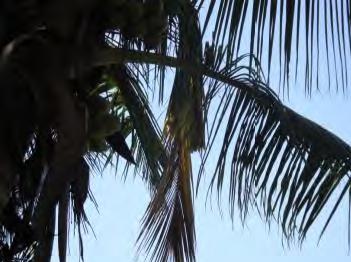 |
| Initial - Young palm damage |
Later - Non typical V shaped damage |
| |
|
Identification of the pest
- Egg: oval creamy white egg in manure pits or decaying vegetable matter at a depth of 5 to 15 cm
- rub: Grub is stout, sluggish, white “C”-shaped with pale brown head and found at a depth of 5 to 30 cm.
- Pupa : Grub pupates in earthern cells at a depth of 0.3 to 1 m
- Adult: Adult beetle is stout, brownish black or black and has a long horn projecting dorsally from the head in male. Horn is short in female.
|
|
Management
- Remove and burn all dead coconut trees in the garden (which are likely to serve as breeding ground) to maintain good sanitation.
- Collect and destroy the various bio-stages of the beetle from the manure pits (breeding ground of the pest) whenever manure is lifted from the pits.
- Incorporate the entomopathogen i.e, fungus (Metarrhizium anisopliae) in manure pits to check the perpetuation of the pest.
- Soak castor cake at 1 kg in 5 l of water in small mud pots and keep them in the coconut gardens to attract and kill the adults.
- Treat the longitudinally split tender coconut stem and green petiole of fronds with fresh toddy and keep them in the garden to attract and trap the beetles.
- Examine the crowns of tree at every harvest and hook out and kill the adults.
- For seedlings, apply 3 naphthalene balls/palm weighing 3.5 g each at the base of inter space in leaf sheath in the 3 inner most leaves of the crown once in 45 days.
- Set up light traps following the first rains in summer and monsoon 200 period to attract and kill the adult beetles.
- Field release of Baculovirus inoculated adult rhinoceros beetle @ 15/ha reduces the leaf and crown damage caused by this beetle.
- Apply mixture of either neem seed powder + sand (1:2) @150 g per palm or neem seed kernel powder + sand (1:2) @150 g per palm in the base of the 3 inner most leaves in the crown
- Place phorate 10 G 5 g in perforated sachets in two inner most leaf axils for 2 times at 6 months intervals.
- Set up rhinolure pheromone trap @ 1/ 2 ha to trap and kill the beetles.
|
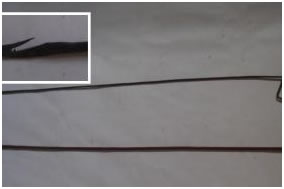 |
Iron rods use for hooking rhinocerus beetles |
|
Top
|
2. Red palm weevil: Rhynchophorus ferrugineus |
Symptoms of damage
- Holes on trunk with with brownish ooze
- Yellowing of inner leaves
- Gradual wilting of central shoot in the crown
|
|
|
|
Brownish oozing |
Central shoots wilting - Later |
Leaf damage - Initial |
|
Identification of the pest
|
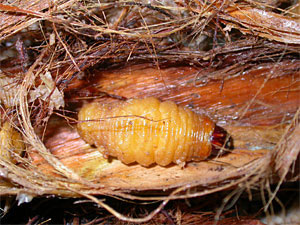 |
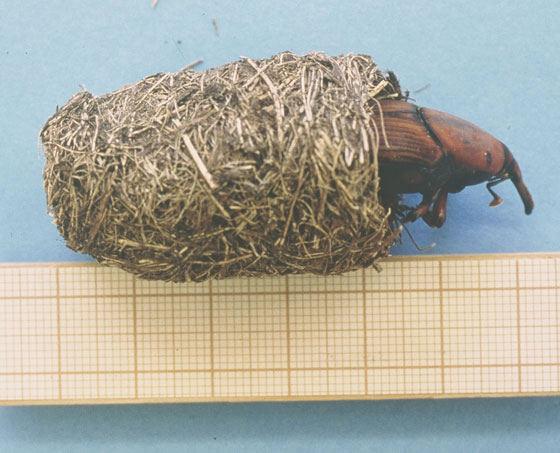 |
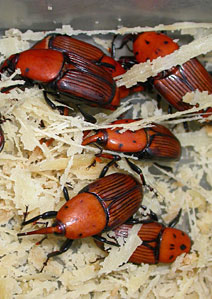 |
Pupa |
Emerging from coccon |
Adult |
|
Management
- Remove and burn all wilting or damaged palms in coconut gardens to
prevent further perpetuation of the pest.
- Avoid injuries on stems of palms as the wounds may serve as
oviposition sites for the weevil. Fill all holes in the stem with cement.
- Avoid the cutting of green leaves. If needed, they should be cut about
120 cm away from the stem.
- Fill the crown and the axils of top most three leaves with a mixture of
fine sand and neem seed powder or neem seed kernel powder (2:1)
once in three months to prevent the attack of rhinoceros beetle damage
in which the red palm weevil lays eggs.
- Setting up of attractant traps (mud pots) containing sugarcane
molasses 2½ kg or toddy 2½ litres + acetic acid 5 ml + yeast 5 g +
longitudinally split tender coconut stem/logs of green petiole of leaves
of 30 numbers in one acre to trap adult red palm weevils in large
numbers.
- Install pheromone trap @1/2 ha
- Root feeding: As under black headed caterpillar
|
 |
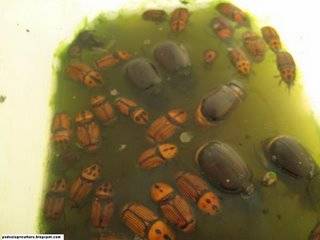 |
| Pheromone lure with bucket |
Trap the red palm weevil and weekly catching the rhinoceros beetle |
|
Top
|
3. Bark weevil: Dicalandra stigmaticolis |
Symptoms of damage
- Reddening of petioles and trunks especially around wounds
- Trees with stem bleeding disease
|
Identification of the pest
- Adult: Small black in colour
- Stem injection through a stove wick soaked in 0.2% fenthion or 0.2% dichlorvos and plugging the hole and repeating the treatment using the same wick and hole a month after.
|
Top
|
4. Shot hole or Bark borer: Xyleborus parvulus |
- Presence of lot on minute holes interconnected by fibrous galleris.
Identification of the pest
- Adult: Small brown weevil
|
Top
|
5. Black headed caterpillar: Opisina arenosella |
- Dried up patches on leaflets of the lower leaves
- Galleries of silk and frass on under side of leaflets.
|
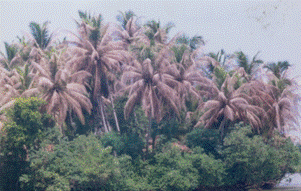 |
 |
Burnt appearence |
|
 |
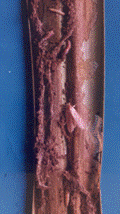 |
Identification of the pest
Larva
- Caterpillar is greenish brown with dark brown head and prothorax, and a reddish mesothorax.
- It has brown stripes on the body
Pupa
- It pupates inside the web itself in a thin silken cocoon
Adult
- Moth: Greyish white in colour
- Female: with long antenna and three faint spots on the forewings
- Male: with fringed hairs in hind wings in apical and anal margin.
|
|
- The incidence of the pest is noticed from the month of November toMay and from August to November after rainfall. The coconut trees of all ages are attacked.
- Release the larval (Bethylid, Braconid and Ichneumonid) and pupal
(Eulophid) on (chalcid) parasitoids and predators periodically from
January, to check the build up of the pest during summer.
- Among the larval parasitoids, the bethylid Goniozus nephantidis is the
most effective in controlling the pest. The optimum level of release is
1:8 of host-parasitoid ratio. The parasitoid should be released
@3000/ha under the coconut trees when the pest is in the 2nd or 3rd
instar larval stage. Parasitoid release trap may be used to release the
parasitoid at the site of feeding. Parasitoids should not be released in
the crown region since they will be killed by predators like spiders and
reduviid bugs.
- Remove and burn all affected leaves/leaflets.
- Spray malathion 50 EC 0.05% (1mi/lit) to cover the undersurface of the
leaves thoroughly in case of severe epidemic outbreak of the pest in
young palms.
- Root feeding for the control of coconut Black headed caterpillar:
- Select a fresh and live root, cut sharply at an angle and insert the root
in the insecticidal solution containing
water 10 ml in a 7 x 10 cm polythene bag. Secure the bag tightly to the
root with a cotton thread. Twenty four hours later, check whether there
is absorption. If there is no absorption select another root. These
methods should not be resorted to as a routine practice and it is
suggested only for cases of severe epidemic outbreak of the pest and
when the survival of the tree is threatened.
|
Top
|
6. Slug caterpillar: Parasa lepida and Contheyla rotunda |
|
|
Identification of the pest
 |
i. Parasa lepida
- Egg: Flat shiny eggs on the under surface of leaves
- Larva: Greenish body with white lines and four rows of spiny scoli tipped red or black, which cause irritation and pain.
- Pupa: It pupates in a compact elliptical chocolate brown shell like cocoon, which is convex above and flat ventrally as stems. Cocoons are covered with irritating spines and hairs
- Adult: Adult moth has green wings with prominent dark patch at the base of each forewing.
|
- Larva- Black or grey dorsally and dorso laterally.
- Adult - Small greyish brown moth. Forewings have slight dark in colour and series of black points. Hind wings are slightly darker.
|
Management
Spray any one of the following
- Dichorvos 76 WSC 2 ml/lit
- Bacillus thuringiensis 2 g/lit,
- Triazophos 40 EC 5 ml
- Methyl demeton 25 EC 4 ml/lit
- Root feeding with 15 ml of water
|
Top
|
7. Coconut skipper: Gangara thyrsis ; Suastus gremius |
- Tip of the leaflets rolled
Identification of the pest
i. Gangara thyrsis
- Larva: - Pale green with reddish markings. Body concealed in a covering of white waxy markings
- Adult: Butterfly-brownish in colour. Chocolate brown wing with yellow spots
ii. Suastus gremius
Symptoms of damage
- One half of the leaflets are cut and rolled into a case
Identification of the pest
- Larva: Smooth, green, tapering at either end with a constriction between head and body
- Adult: Chocolate brown with yellow spots on forewings
- Collect and destroy the immature stages of the insects by conducting study (or neem compaign) wherever possible and spray carbaryl 50 WP 2 gm/lit.
- Root feeding with 10 ml water at 45 days interval for 3 times for control of leaf caterpillar.
- Set up light traps to trap and collect adult moths
- Spray dichlorvos 76 WSC 2 ml / lit.
|
Top
|
8. Leaf caterpillars: Turnaca acuta |
Symptoms of damage
- Feeds on leaflets leaving stick
Identification of the pest
- Larva: -Brown with two pink stripes later turns greenish
- Adult: Dull white
- Collect and destroy the immature stages of the insects by conducting study (or neem compaign) wherever possible and spray carbary 50 WP 2 gm/lit .
- Root feeding with 10 ml water at 45 days interval for 3 times for control of leaf caterpillar.
- Set up light trape to trap and collect adult moths
- Spray Dichlorvas 76 WSC 2 ml / lit.
|
|
Top
|
9. Bag worm: Manatha albipes |
- Small and irregular hole on the leaves
Identification of the pest
Larva: - Inside the conical bags constructed with silk and thread
Management
- Collect and destroy the immature stages of the wherever possible and spray carbary 50 WP 2 gm/lit.
- Root feeding with 10 ml water at 45 days interval for 3 times for control of leaf caterpillar.
- Set up light traps to trap and collect adult moths
- Spray dichlorvas 76 WSC 2 ml / lit.
|
Top
|
10. White grub: Leucopholis coneophora |
- Leaves turn yellow
- Premature nut shedding
- Flowering delayed
- White grubs are exposed when base of tree dug
 |
Identification of the pest
Adult: Brown coloured beetle with striated wings not covering the abdomen fully
Management
- Collect and destroy the adult beetles attracted to trees like neem, Ailanthus andAccasia on the receipt of monsoon showers
- Plant neem twigs with leaves in coconut gardens after rain to attract and kill adult beetles
- Set up light trap @ 1 / ha or bonfire
|
Soil application
- Malathion 5 D 25 kg/ ha at the time of planting
|
|
Top
|
11. Termite: Odontotermes obesus |
Identification of the pest
- Adults: Cream coloured, tiny insects resembling ants with dark coloured head
- Locate termite mounds in or near the coconut nursery or garden and
destroy.
- Swabbing with neem oil 5% once on the base and upto 2 m height of
the trunk for effective control.
- Spray copper sulphate 1% or cashew nut shell oil 80% or spray
chlorphyriphos @ 3ml/lit of water, neem oil 5% or NSKE 20% to
preserve plaited coconut leaves from the termite attack.
|
|
Top
|
12. Lacewing bug: Stephanitis typicus |
- White spots on the upper surface of the leaves
Identification of the pest
- Nymph: White with dark patches
- Adults: White coloured adults with netted venation on wing
- Remove leaflets harbouring these insects and destroy them
Spray any one of the following
- Malathion 50 EC 2 ml/lit
- Dimethoate 30 EC 1 ml/lit
- Methyl demeton 25 EC 1 ml/lit
- Phosphamidon 40 SL 1.25 ml/lit
- Methomyl 25 EC 2 ml/lit
- Neem oil 3%
|
Top
|
13. Scale insect: Aspidiotus destructor |
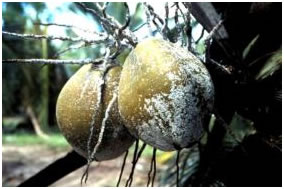 |
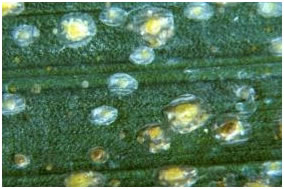 |
Scales on coconut |
Scales on leaves |
|
- Yellowing of leaves in patches, later coalescing together
Identification of the pest
- Nymph - covered with circular waxy secretion
- Pluck mature nuts .
- Do not harvest nuts for 45 days after spraying.
|
Top
|
14. Mealy bug: Pseudococcus longispinus |
- Central leaves stunted , deformed and suppressed
- Shedding of buttons
- Remove leaflets harbouring these insects and destroy them
Spray any one of the following :
- Malathion 50 EC 2 ml/lit
- Dimethoate 30 EC 1 ml/lit
- Methyl demeton 25 EC 1 ml/lit
- Phosphamidon 40 SL 1.25 ml/lit
- Neem oil 30ml/lit.
|
Top
|
| 15. Coconut Eriophyid mite: Aceria guerreronis |
- Triangular pale or yellow patches close to perianth
- Necrotic tissues
- Brown colour patches, longitudinal fissures and splits on the husk
- Oozing of the gummy exudation from the affected surface
- Reduced size and copra content.
- Malformed nuts with cracks and hardened husk.
|
 |
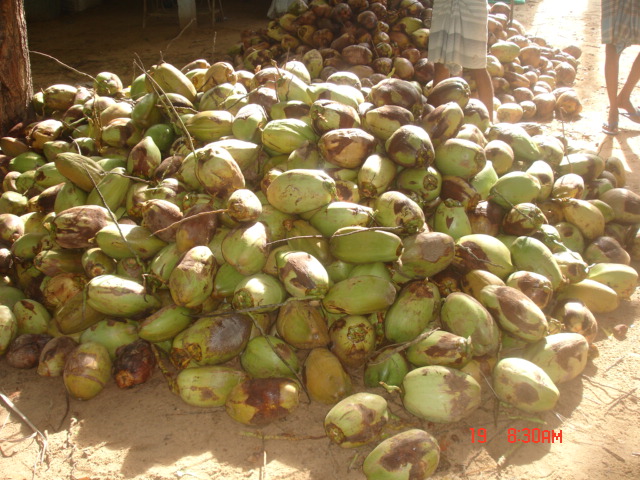 |
Eriophyid mite damage in young developing buttons |
Eriophyid mite affected coconut |
|
Identification of the pest
- Nymph and Adult - Pale in colour with elongate body and worm like appearance
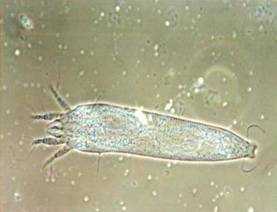
|
- Apply urea 1.3 kg, super phosphate 2.0 and muriate of potash 3.5 kg/palm/year
- Neem cake @ 5 kg and organic manure 50 kg/palm/ year
- Borax 50 g + gypsum 1.0kg + Manganese sulphate 0.5 kg/palm/ year
- Grow intercrop (sun hemp, four crops/year) and shelter belt with casuarina all round the coconut garden to check further entry
- Triazophos 40 EC 5 ml/lit or carbosulfan 25 EC 2 ml/ lit in alternation with neem azal 1% 5ml/lit as spot application
ii. Root feeding
- Root feeding with TNAU - Agro Biocide 30 ml/tree
- TNAU - Agro biocide - 30 ml/tree - (60 days after Carbosulfan root feeding).
- triazophos 40 EC @15 ml or carbosulfan 25EC @ 15 ml / 15 ml of water
- After root feeding, next harvest should be done 45 days later.
|
 |
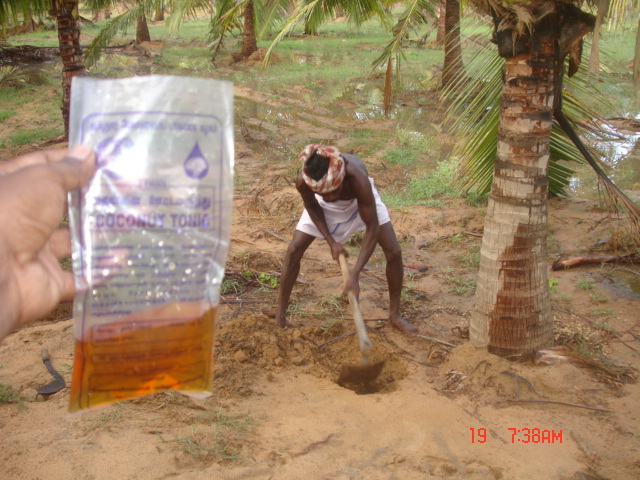 |
Root feeding used by insecticides |
Root feeding used by coconut tonic |
Note: Pluck nuts before root feeding |
| Updated Jan, 2023 |
|
|


